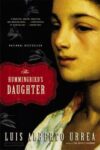
by Luis Alberto Urrea, 2005
Lori J. recommended this book. It was excellent. It’s about Saint Teresa of Cabora in Mexico and her life from the time she is born until she is exiled to the United States. She is the bastard daughter of Don Tomas, a wealthy rancher. He is a very loving man, too loving when it comes to beautiful women. He goes from not acknowledging Teresa (and Buenaventura, his bastard son from another woman), to loving them and accepting them as his own. That’s a beautiful part of the story. Teresa (Teresita) is recognized as special, a healer, when she is very young, by Huila, an old, cranky healer whom everyone depends upon and loves. She trains up Teresa and Teresa becomes an even more powerful healer. Many pilgrims take over the ranch and Teresa spends her days healing, and her father, Don Tomas, helps her pick the lice out of a little boy’s head late one night, and finds new meaning in his life.
Unfortunately, the corrupt government of Mexico, run by President Diaz, is threatened by Teresa and, of course, try to discredit her by spreading lies, and then capture her and her father and put them in prison. The ending is amazing. They have decided to exile Teresa and her father to the United States rather than kill them, and are moving them by train. However, the loyal Indian warriors are determined to ambush the train and rescue Teresa. She knows this, as does the compassionate Captain Enriquez, but she convinces Captain Enriquez not to shoot at any of the warriors as the move slowly through the canyon. She is standing on the flatcar of the train where the warriors can see her and she says to them and to the soldiers on the train, “Don’t shoot, don’t shoot, don’t shoot.” And no one shot. The train moved through the canyon slowly and the warriors saw their saint and she was telling them not to shoot and they obeyed her. No one got hurt. She never wanted any death or violence to take place. She was peaceful and loving.
I loved this book. The dialogue is fun and fast-paced and humorous. The characters are wonderful. There are some terrible things that happen, but the author does not use graphic language. There are a lot of native words used and no definitions provided. At first, I thought about looking them up as I went along, but I didn’t – you can tell what a lot of them mean by the context.
Here’s a description of the proper way to hug, from Manuelito, a medicine man teaching Teresa:
“Christians don’t like the left side, but Indians do. Christians have forgotten their hearts. When a medicine woman hugs you, if she means it, she will move you to the side and put her heart on yours. Does Huila do this?”
She’s talking to Cruz Chavez, an Indian warrior from a mountain village (Tomochic) who has come to see if Teresa is really a saint:
“What do you think our work is here on earth?” he asked.
“Love for God, love for each other. Reconciliation. Service.” She poked him with a finger. “Joy!”
Cruz Chavez writes a letter to Teresa and tells her of his conversation with Father Gastelum, the corrupt Catholic priest who visited them and is telling them lies about Teresa:
“–Perhaps. But if she is evil, why are her actions purely generous, acts of charity and pity? Love. And thou and the rest of thine priests only preach hatred. Why is this? You hate all who are not Romans, and all you conspire to do is to take our money!
—Tithes! he cried.
–She has never asked a tithe of us! yelled Ruben. –She has only given succor!
I interrupted him: — Can you tell us why Satan would advise people to love God and their neighbors while you, who are representatives of God, advise us to hate anyone who does not follow your religion?”